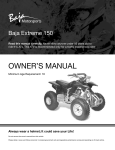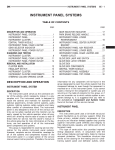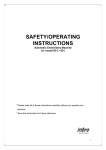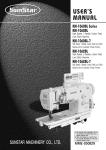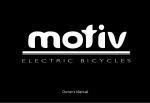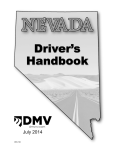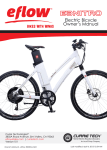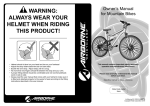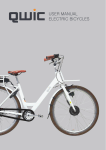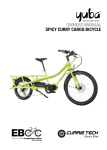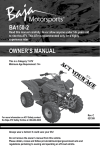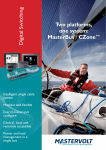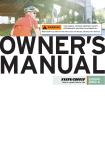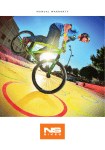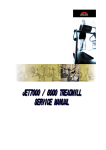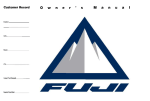Download ELECTRIC BIKES | USER MANUAL
Transcript
ELECTRIC BIKES | USER MANUAL THANK YOU FOR PURCHASING AN OHM. We welcome you to the exciting and revolutionary world of alternative transportation. Your high quality, power on demand OHM bicycle offers a new form of environmentally friendly transportation and recreation. Throughout this Manual you will find useful tips and important safety, performance and maintenance information to ensure you enjoy all features OHM bicycles have to offer for your riding enjoyment. NOTE: It is important to understand that this is not a comprehensive use, repair or service Manual. Please contact your local OHM dealer for all service, repair and maintenance. Your local dealer will also be able to refer you to additional books, DVDs, websites or cycling clinics/ classes available in your community to broaden your skills and knowledge in bicycle use, repair and maintenance. ABOUT THIS MANUAL: The main purpose of producing this owner’s Manual is to ensure your safety at all times while enjoying our product. Along with many others in the cycling community, we constantly strive to reduce possible risks associated with our products. We also recognize the importance of you, the rider, to clearly understand that with proper instruction of bicycle use and maintenance, the risk of cycling-related accidents can be reduced. It is within this context we created the following Manual and invite you to take responsibility to learn about how to reduce inherent risks while bicycling and enjoying your OHM bicycle. We also wrote the Manual to ensure readability and ease in efficiently finding information. We strongly recommend that you read the entire Manual and look for the WARNINGS or CAUTIONS we have included throughout to alert you to potential risks of injury and/or damage. ohmcycles.com THANK YOU IMPORTANT: Please read this Manual before taking your first ride on your OHM bicycle. It is very important to familiarize yourself with the product to ensure you experience the bike’s full performance potential, all the while ensuring your safety and riding pleasure. We also recommend that you keep the Manual on hand for future reference. 3 >> CONTENTS CONTENTS GENERAL WARNING........................................................................................................................................................................6 ONE > BEFORE YOU RIDE................................................................................................................................... 7 4 1.1 1.2 1.3 1.4 1.5 BIKE FIT...................................................................................................................................................................................................... 7 SAFETY FIRST!........................................................................................................................................................................................... 7 MECHANICAL SAFETY CHECK................................................................................................................................................................. 8 SOME ADDITIONAL PREPARATIONS....................................................................................................................................................... 10 FIRST RIDE............................................................................................................................................................................................... 10 2.1 2.2 2.3 2.4 2.5 2.6 2.7 THE BASICS............................................................................................................................................................................................. 12 RIDING SAFETY....................................................................................................................................................................................... 12 OFF ROAD SAFETY.................................................................................................................................................................................. 14 WET WEATHER RIDING........................................................................................................................................................................... 15 NIGHT RIDING.......................................................................................................................................................................................... 15 EFFICIENT RIDING TECHNIQUE............................................................................................................................................................... 16 CHANGING COMPONENTS OR ADDING ACCESSORIES....................................................................................................................... 17 3.1 3.2 3.3 3.4 3.5 3.6 STANDOVER HEIGHT............................................................................................................................................................................... 18 OHM FRAME FIT...................................................................................................................................................................................... 19 SADDLE POSITION.................................................................................................................................................................................. 19 HANDLEBAR HEIGHT AND ANGLE......................................................................................................................................................... 20 CONTROL POSITION ADJUSTMENTS.................................................................................................................................................... 21 BRAKE REACH......................................................................................................................................................................................... 21 TWO > SAFETY.................................................................................................................................................... 12 THREE > FIT......................................................................................................................................................... 18 ohmcycles.com 4.1 4.2 4.3 4.4 4.5 4.6 4.7 4.8 WHEELS................................................................................................................................................................................................... 22 SEATPOST QUICK RELEASE................................................................................................................................................................... 26 BRAKES................................................................................................................................................................................................... 27 SHIFTING GEARS..................................................................................................................................................................................... 28 PEDALS....................................................................................................................................................................................................30 BICYCLE SUSPENSION........................................................................................................................................................................... 32 TIRES AND TUBES...................................................................................................................................................................................33 POWER ASSIST DRIVE SYSTEM..............................................................................................................................................................35 5.1 5.2 5.3 5.4 SERVICE INTERVALS................................................................................................................................................................................ 37 GETTING HOME WHEN SOMETHING BREAKS......................................................................................................................................38 IF YOUR BICYCLE SUSTAINS AN IMPACT...............................................................................................................................................40 BATTERY CARE........................................................................................................................................................................................40 FIVE > SERVICE................................................................................................................................................... 36 SIX > ABOUT YOUR OHM DEALER................................................................................................................... 41 6.1 ACCESSORIES......................................................................................................................................................................................... 41 SEVEN > LIMITED WARRANTY......................................................................................................................... 42 7.1 WARRANTY REGISTRATION....................................................................................................................................................................43 ohmcycles.com CONTENTS FOUR > TECHNICAL INFORMATION................................................................................................................ 22 5 GENERAL WARNING 6 Like many forms of transportation and recreation, bicycling involves the potential risk of injury and/or damage. By choosing to cycle, you are assuming responsibility for these risks. In an attempt to reduce the risk, we believe you need to know and practice the rules of safe and responsible riding and of proper use and maintenance, which will help to reduce the risk of injury or damage. Consequently, you will find many “WARNINGS” and “CAUTIONS” throughout this Manual followed by discussions on the consequences in failing to inspect and maintain your bicycle and/or following safe cycling protocol. Again, we recommend you familiarize yourself with this information since we are highlighting it with your safety in mind. It is impossible to anticipate or discuss all situations or conditions in this Manual, which may or may not lead to injury or damage while riding this bicycle. We have taken the utmost care and attention in manufacturing a safe and reliable product and in providing you with this informative Manual that will assist you in reducing risks associated while using your bicycle. However, there are risks that cannot be predicted or avoided, and consequently, are the sole responsibility of you, the rider. Our intention here is not to cast fear in riding a bicycle, but instead to recognize the potential dangers associated with traveling on two wheels and thereby ensuring a safe and enjoyable experience. • The combination of the safety alert symbol and the word WARNING indicates a potentially hazardous situation which, if not avoided, could result in serious injury or death. safety alert symbol and the word CAUTION indicates a potentially hazardous situation which, if not avoided, may •T he combination of the result in minor or moderate injury, or is an alert against unsafe practices. • The word CAUTION used without the safety alert symbol indicates a situation which, if not avoided, could result in serious damage to the bicycle or the voiding of your warranty. ohmcycles.com >> NOTE: As already strongly recommended, please read this Manual in its entirety. Here we explain the importance of fitting the bike, safety and general maintenance. Be sure you understand each point in this section before setting out on your first ride. Refer to specific sections of the Manual for detailed content to ensure you are prepared and ready for a safe and enjoyable ride. 1.1 BIKE FIT 1 > The fit of your bicycle is extremely important. If the bicycle is too large or too small, this may pose a danger in causing you to lose control or fall. In addition, proper fit is essential for maximum performance and comfort. To determine the right size of bike that suits your body, go to Sections 3.1 and 3.2. Your dealer will also be able to assist you in finding the right size. When referring to size, bicycles are measured according to the frame size. This number signifies the size of the frame and the overall size of the bike. 2 > With the right sized frame, you can now adjust accessories to maximize safety, comfort and performance. Start with determining whether your seat height is set correctly. To check this and/or make adjustments, go to Section 3.3. 3 > Now check to ensure the saddle is securely fastened to the post (see Section 3.3) and the post clamp is secured (see Section 4.2). A securely fastened saddle does not move in any direction and a secure post clamp prevents the post from sliding up or down. 4 > Check to see if the handlebars and stem are set at the right height for you and are secure. To confirm, go to Section 3.4. 5 > Now check the brakes. Squeeze the brake levers. Can you operate them with ease? Do you see the front brake pads grasping the disc when you squeeze the brake levers? It is also a good idea to lift your bicycle, spin each wheel, grasp the brake and ensure proper function. If the brake does not function with ease have your local dealer/mechanic adjust them. 6 > Lastly, ensure you fully understand how to operate your new OHM bicycle (see Section 4.9). Your new bicycle offers features unlike regular pedal operated bicycles. Contact your local dealer to have any features or functions explained to you before your first ride. 1.2 SAFETY FIRST! 1 > ALWAYS WEAR AN APPROVED HELMET WHEN RIDING YOUR OHM BICYCLE. Please refer to your helmet manufacturer’s instructions for proper fit, use and care of the helmet. Helmets are available from your dealer. 2 > Check to see that you have all required and recommended safety equipment for your first and future rides. Also, be sure that you know all laws pertaining to cycling in your region. The laws may include where you can cycle, the use of hand signals or the need for mandatory equipment while cycling. 3 > Next, are your wheels securely fastened to the frame/forks? Wheels that are not safely secure can wobble and impede the bicycle performance or worse, dislodge while riding and cause injury or death. For your OHM bicycle, the front wheel has a quick release mounting mechanism and the rear wheel has a bolted ohmcycles.com ONE > BEFORE YOU RIDE ONE > BEFORE YOU RIDE 7 ONE > BEFORE YOU RIDE mounted device. See Section 4.1 for an explanation on how to properly secure both types of mounting devices. 8 4 > Now look at your pedals. Check to see that they are securely fastened and the pedals spin freely. 5 > Your OHM bicycle comes equipped with a suspension fork and a suspension seat post. It is very important that you understand how the suspension works because it will influence the performance and handling of the bicycle. Either consult your local dealer to explain or read Section 4.6. 6 > Check to see if you have “toe-overlap” – this can occur with smaller sized frames when your toe(s) make contact with the front wheel when the wheel is turned and the pedal is in a forward position. This can cause injury or harm to you and/or your bicycle. If you are rubbing the front wheel (or any other part of the bicycle while pedaling) see Section 4.5 or contact your local dealer before you ride. 7 > Check to see that the lighting system is operating at peak performance. To activate the lights, press the Mode button for three seconds and check the rear and front fixture for strong light output. It may be helpful to roll your bike up to a wall and turn the light on to see the output level and angle of the light. Please refer to the lighting system manufacturer’s Manual for more information about light output and adjusting the fixture angles for peak performance. 8 > Check to see that the battery is fully charged and operating properly. Look for a full battery charge level on the command console. If this is not the case, refer to Section 5.4 on charging your battery. Always make sure your battery container is well fastened to the frame and locked. ohmcycles.com 1.3 MECHANICAL SAFETY CHECK=Always do a complete check of the condition of your bike before every ride. We also recommend regular maintenance of your bicycle to prolong the life of the components and maximize safety. ✔ Nuts, Bolts and Straps: Ensure all are secure. An easy way to test for this is to lift the front wheel off the ground by two or three inches and then drop the wheel. Listen, watch and feel for anything loose. Do the same for the rear wheel. Next, do a quick visual and tactile inspection of the entire bicycle. If you find something loose, tighten it before your ride. This is a good habit to develop before each ride. Lastly, if you do discover something you are not sure about, please consult your local dealer to ensure all is safe. ✔ Tires and Wheels: Make sure your tires have the correct amount of air pressure. Tires with too little or too much air pressure can impede performance and be unsafe while riding your bike. To ensure your tires are at the necessary air pressure (or psi), there are two steps you can follow. First, if you have a tire gauge, apply it to the tire valve and check the psi. Much like a tire on a car, the recommended psi is stamped on the sidewall of the bicycle tire. When you are sure the tire is set to the correct psi, squeeze the tire to familiarize yourself with how the tire should feel to your hand. With your tires ready to roll, slowly spin each wheel and watch for any cuts in the tread and sidewall, or road debris lodged in the tire such as wood, glass or nails. Remove any debris and ALWAYS replace any tires with cuts or visual damage before you ride. Lastly, check to ensure your wheel (or rim) spins straight or “true” – this means that when you spin the wheel, it does not wobble side to side or rub against your brake pads. If you find your wheel wobbles side to side or rubs against CAUTION: For your brakes to work effectively, the wheel (or rim) must be “true.” Do not attempt to true a wheel unless you have the knowledge, tools and experience. Truing the wheel is better left to your local bicycle mechanic to ensure your wheel performs properly and safely. ✔ Brakes: Check to see the brakes are working correctly (see Section 4.3). Squeeze the brake levers for both front and rear brakes and look to see if the front wheel quick-release lever is closed, all control cables are seated and securely engaged, and that the brake discs are intact. Also, check that the brake levers, when fully squeezed, do not touch the handle-bar. If you find a problem, DO NOT RIDE THE BICYCLE and take the bicycle to your local dealer for service. WARNING: Loose or damaged handlebar grips can cause you to lose control of the bicycle and fall. Unplugged handlebar ends can cut your body (handlebar ends are often cut when the bicycle is assembled and may not be filed to remove sharp edges or spurs) and can cause serious injury in an otherwise minor accident. ✔ Bicycle Suspension: For your seat post suspension, check the rail clamp plate screw for proper torque and that the seat post quick-release is properly tightened (see Section 4.6 for more details). For the front suspension fork, ensure that it is set correctly for the terrain you have chosen for your ride. ✔ Battery Container: Ensure the battery container is locked in place and connected; check by depressing the mode button on the command console to confirm digital control activation. ✔ Quick Release: Check to see the front wheel and seat post quick-release mounts are properly adjusted and securely fastened. (see Sections 4.1.1 and 4.2, respectively) ✔ Handlebar and Saddle Adjustment: Check to see the handlebar stem and suspension seat post are properly aligned and securely fastened. Make sure the handlebar stem and suspension seat post are parallel with the bicycle’s “centre line” (imagine a straight line that runs from the rear tire to the front tire). Also, ensure the stem and post are clamped securely so that neither can be twisted or moved. ✔ Handlebar Ends: Check to see the handlebar grips are secure and in good condition. ohmcycles.com ONE > BEFORE YOU RIDE the brake pad even slightly, take your bicycle to your local bicycle mechanic to have the wheel trued. 9 1.4 SOME ADDITIONAL PREPARATIONS ONE > BEFORE YOU RIDE Here are some additional preparations we recommend to help in ensuring you have a safe and comfortable ride: 10 ✔ Carry a good quality hand pump, patch kit, spare tube and know how to repair a tire (see Section 5.2 and Section 4.7). Take a bicycle maintenance/repair course or access the many books/ DVDs that your OHM dealer can recommend. ✔ Carry sufficient water (e.g., water bottles, water bladders, etc.) and food to ensure your body is properly fueled. Although your bicycle is equipped with power on demand, your body is also a contributing engine – no fuel, no go! ✔ Dress appropriately. Wear form fitting yet comfortable clothing designed for cycling. A good pair of shorts, jacket, gloves and glasses will ease wear and tear of long and short rides (see Sections 2.1 (#5), 2.4 and 2.5 for more information). ✔ As with any activity in life, take a good attitude. Relax and enjoy your ride – there is no hurry. Ride according to your athletic ability but also know you have power on demand to assist you. 1.5 FIRST RIDE It is time for your first ride. Before you strap on your helmet and prepare to ride, take a moment to choose a location that is a controlled environment to allow time to familiarize yourself with the controls, features and performance of your bike. The location should be clear of cars, other cyclists, obstacles or other hazards. Be sure to familiarize yourself with the braking system of the bike (see Section 4.3). Start with riding at a slow speed and test the ohmcycles.com brakes. Put your weight toward the rear and gently apply the rear brakes first before engaging the front brakes. Sudden or excessive application of the front brakes can cause your body to lunge forward and could pitch you over the handlebars. Applying brakes too hard at anytime when riding can lock up a wheel, which can cause you to lose control and fall. If your bicycle has clipless pedals, be sure to practice getting in and out of them (see Section 4.5). Your bicycle comes equipped with a suspension seat post and front fork suspension. Familiarize yourself with how the suspension systems respond to brake application and rider weight shifts (see Section 4.6). Next, practice shifting the gears (see Section 4.4) while pedaling do not attempt to shift gears when not pedaling. Also, remember not to shift gears when pedaling backwards or pedal backwards after shifting gears. This could jam the chain and cause serious damage to the bicycle and drivetrain. Familiarize yourself with the power assist drive system (see Section 4.9) in order to safely enjoy this feature. Take time to be comfortable with the command console. Finally, familiarize yourself with the overall handling and response of the bike and ensure you are comfortable while riding the bicycle. If you have any questions, please contact your local OHM dealer for assistance. See Section 6.1 for contact information. OWNER’S RECORD First Name: ONE > BEFORE YOU RIDE Please fill out the following Warranty Registration for your records and mail a copy of the Warranty Card to OHM Cycles, or register on-line. Model: Last name: Serial number: Address: Date of sale (MM/DD/YY): Dealer name: City: State/Province: Notes: ZIP/postal code: 11 Country: Phone: ( ) Email: ohmcycles.com TWO > SAFETY TWO > SAFETY 2.1 THE BASICS 12 1 > Always wear a bicycling helmet that meets the latest certification standards and follow the helmet manufacturer’s instructions for proper fit, use and care of your helmet. Most serious bicycle injuries involve head injuries, which may have been avoided if the rider had worn a helmet. Fig 2.1 WARNING: Failure to wear your helmet when riding a bicycle may result in serious injury or death. ✔ A ppropriate cycling clothing that is bright, visible and fit snugly to your body. Loose clothing can tangle in your drivetrain or wheel or be snagged by objects at the side of the road or trail. ✔ Protective eyewear to protect against airborne dirt, dust and bugs. Also, if it is sunny, wear tinted lenses and, depending on your riding preference, clear, yellow or orange lenses when not. 6 > Do not jump with your OHM bike. Jumping a bike can be fun, but it puts you and your bike at risk of serious harm. Jumping causes stress on everything from the spokes to your pedals, and if you lose control, you can cause serious injury or death. If you insist on jumping your bicycle, understand that you are doing this at your own risk. 7 > Ride your bicycle at a speed that is appropriate for the conditions in which you are riding. 2.2 RIDING SAFETY 2 > Always do the Mechanical Safety Check before you get on your bike (see Section 1.3). 3 > Be competent in operating the controls on your bicycle: brakes (see Section 4.3); pedals (see Section 4.5), shifting (see Section 4.4) and power assist drive system (see Section 4.9). 4 > Be careful to keep body parts, clothing and other objects clear from the sharp teeth of the chainrings, the moving chain, the turning pedals and cranks, and the spinning wheels of your bicycle. 5 > Always wear: ✔ Shoes that fit your feet properly and grip the pedal securely. Do not ride your bicycle barefoot or with loose fitting shoes such as sandals. ohmcycles.com 1 > Observe all local bicycle laws and regulations. Pertinent laws include, but are not limited to, helmet laws, child carrier laws and special bicycle traffic laws. Important regulations include, but are not limited to, licensing of bicycles, riding on sidewalks, and regulations concerning bike path and trail use. It is your responsibility to learn and obey all laws and all regulations that pertain to cycling in your area. 2 > Always respect the rights of other road or path users such as motorists, pedestrians and other cyclists. 3 > Ride defensively. Always assume that others do not see you. Never underestimate the unpredictability and risks associated with road riding. • Vehicles slowing or turning, entering the road or your lane ahead of you, or coming up behind you. • Parked car door opening – it is a good habit to scan parked cars for people in the driver seat to alert you to the possibility of a door opening. •P edestrians stepping out • Children or pets playing near the road • Hazardous road conditions: pot holes, gravel, sewer grates, expansion joints, road or sidewalk construction, debris and other obstructions that could cause you to swerve into traffic, catch your wheel or otherwise cause you to lose control and have an accident. • The many other hazards and distractions, which can occur on a bicycle ride. 5 > Whenever possible, ride within designated bike lanes, on designated bike paths or if riding on the road, ride as close to the edge as possible. If you feel uncomfortable with the riding conditions (e.g., road with very narrow shoulder or no shoulder at all) seek out alternative routes that are safe. 6 > Obey all traffic laws. Stop at all stop signs and traffic lights and slow down to look both ways before proceeding through all intersections regardless of whether you have the right of way or not. Remember that a collision with a vehicle, whether the driver’s fault or not, will likely cause you much more harm than the vehicle. 7 > Learn and use hand signals to let other users on the road know where you are turning or changing your position while on the road. 8 > Never ride with headphones. They may mask important traffic sounds and emergency vehicle sirens. The headphones, or the sounds they are amplifying may distract you from concentrating on what is happening around you. 9 > Never hitch a ride from vehicles or other cyclists. 10 > Never ride your bicycle while under the influence of alcohol or drugs. 11 > Observe and yield the right of way at all times, especially for vehicles. 12 > Always respect the road – do not weave in and out of traffic or make any sudden moves that may surprise other people with whom you are sharing the road. 13 > Do not perform jumps, stunts or wheelies -- they can cause you to lose control of your bicycle and result in injury or death and/or damage to your bicycle. 14 > Never carry a passenger unless it is a small child wearing a certified bicycle helmet and who is secure in a certified and correctly mounted child carrier or a child-carrying trailer. 15 > Never wear or carry anything that obstructs your vision or impairs complete control of your bike or which can become entangled in the moving parts of your bicycle. 16 > Whenever possible, avoid riding your bike in conditions with poor visibility or are hazardous, such as in bad weather, riding at dusk or in the dark, or when you are extremely tired. Each of these conditions increases the risk of an accident. 17 > Your new OHM bicycle purchase will inevitably create much excitement and the opportunity to ride with other people can also be exhilarating. Do not get so carried away that you forget safety precautions, traffic laws and common sense – always ride safely and defensively to enjoy many more rides to come! ohmcycles.com TWO > SAFETY 4 > Some helpful defensive habits include looking ahead to avoid: 13 TWO > SAFETY 2.3 OFF ROAD SAFETY 14 1 > Just as in road riding, never underestimate the unpredictability and risks associated with off-road riding. The variable conditions and hazards of off-road riding demand close attention and specific skills. If you are riding off-road for the first time, consider riding with others with experience or, if available, take an off-road riding course in your community. Ask your local dealer for information. Regardless, start slowly and choose a relatively flat and easy terrain to build up your skills and confidence. Your OHM bicycle comes equipped with front suspension and seatpost, which will take some time to get used to as the suspension does soften the ride and may allow you to experience increased speeds. The increased speed may cause you to lose control of your bicycle and fall. Get to know how to handle your bike safely before increasing speeds or advanced terrain. 2 > Always wear appropriate safety gear required for the type of riding you are doing (see Sections 2.4 and 2.5). Ask your dealer for more information. 3 > Do not perform jumps, stunts or wheelies -- they can cause you to lose control of your bicycle and result in injury or death and/or damage to your bicycle. 4 > Never ride alone when in remote areas. Even if riding with other people, always ensure someone (e.g., friend, family member, co-worker) knows where you are and when to expect your return. 5 > Ensure you ride on trails designated for or permit bicycling. Learn and obey all laws regulating how and where you can ride off-road. Always respect private property, which can be difficult to know in remote areas. 6 > Be respectful of the rights of other trail users – motorists, pedestrians, equestrians and other cyclists. ohmcycles.com 7 > Yield right of way to pedestrians and animals. Always ride in a way that does not startle, surprise or endanger them. Stay far enough away so that their unexpected moves do not endanger you. Communicate with the person or animal before approaching to alert them of your presence, to reduce the chance of startling them. 8 > Always stay on the designated trail and respect the natural environment. Do not contribute to erosion by riding in mud or with unnecessary sliding or skidding. Avoid locking the wheels as much as possible to prevent skidding and additional erosion. Do not disturb the ecosystem by cutting your own trail or shortcut through vegetation or streams. It is your responsibility to minimize your impact on the environment. Always leave the natural environment as you find it and always take out everything (e.g., food wrappers, accessories) you brought in. 9 > BE PREPARED. Ensure you have adequate food/water, appropriate clothing for a range of weather conditions and essential tools. WARNING: Wet weather impairs traction, braking performance and visibility for you and your bicycle and other motorists or cyclists on the road. The risk of an accident is dramatically increased while riding in wet weather. Wet weather can make it harder to control your bicycle and easier to lose control. Wet conditions can dramatically reduce the stopping power of your braking system (and for those of other vehicles or cyclists on the road). In addition, your tires will not grip as well as in drier conditions, which can impair braking. Exercise extra caution and safety when riding in wet weather by riding more slowly and applying your brakes earlier and more gradually than you would in drier conditions. Comfort while riding your bike in wet weather can also be impaired. Fortunately, there is a range of clothing available to help keep you warm and dry, which will benefit you in terms of conserving energy and ensuring you can remain focused on the road. Dress appropriately for the weather conditions in which you are riding. Check with your local dealer for a selection of clothing options and accessories. 2.5 NIGHT RIDING Riding a bicycle at night is many times more dangerous than riding during daylight hours. It can be more difficult for motorists and pedestrians to see you while riding your bicycle at night. Your OHM bicycle does come equipped with a quality lighting system to increase your visibility by motorists and pedestrians and to improve your vision as you ride. However, a lighting system does not provide the same amount of light as daylight and therefore we remind you to ride at your own risk. We do advise that children should never ride at dawn, at dusk or at night and adults ride at their own discretion. WARNING: Please remember that riding at dusk, dawn, at night or in conditions of poor visibility, without your lighting system operating properly is dangerous and may result in serious injury or death. WARNING: Check to see that your lighting system is operating properly and that the fixtures (front and back) are clean, straight, unbroken and securely mounted. Have your local dealer replace or repair damaged fixtures and straighten or tighten any that are bent or loose. Your dealer can also assist you in repairing any problems with the lighting system overall. It is a very good habit to regularly check to see that your lighting system is operating at peak performance. ohmcycles.com TWO > SAFETY 2.4 WET WEATHER RIDING 15 If you choose to ride under conditions of poor visibility, always check to ensure you comply with local laws pertaining to riding a bicycle at night and take the following strongly recommended additional precautions: TWO > SAFETY • Make sure your bicycle’s lighting system is operating properly, is correctly positioned and securely mounted (see Section 4.8) 16 • Always wear reflective and brightly coloured clothing and accessories such as reflective vest, reflective arm and leg bands, and reflective strips on your helmet*. Any reflective device and bright lighting systems will help attract attention from motorist, pedestrians or other cyclists on the road. • Ensure that none of your clothing or accessories are obstructing light fixtures or reflective pieces. * Note: Please check your certified helmet manufacturer’s warranty details to ensure that adding a reflective strip does not void the warranty before attaching anything to your helmet. If in doubt, contact your local dealer for assistance. While riding at dusk, dawn or in conditions of poor visibility, ride safely and cautiously. Avoid dark areas or areas with heavy or fastmoving traffic. Avoid road hazards and if possible, ride on familiar routes. If this is not possible, try to find well-lit routes with minimal traffic. 2.6 EFFICIENT RIDING TECHNIQUE Enjoying your ride is directly associated with ensuring you have sufficient energy throughout the duration of your ride. It is important to learn to ride efficiently. You may have noticed that experienced bicycle riders look smooth and relaxed as they pedal, legs turning circles, almost flowing, which is a good indicator that they are using their energy efficiently. By riding smoothly, you will have more energy and better control of your bike. Here are some tips to keep in mind or even visualize while riding: • Both road and off-road riders need to strive to keep their upper body relaxed and relatively free of movement (e.g., hips should not be rocking side to side) except if you dismount or stand on the pedals to climb a hill. • Remain on your seat as much as possible – standing on the pedals can burn more energy than while remaining mounted on the saddle. • Remember to breathe! Learn proper breathing techniques when riding hard or climbing hills to help keep your muscles fresh and your mind focused. Your OHM bicycle comes equipped with an intelligent energy management system that helps you maximize your riding efficiency (see Section 4.9). Your bike must be fitted correctly to your body. With a properly fitted bike, you can then focus on your posture and pedal techniques to develop a smooth, brisk, confident, and round pedaling stroke. ohmcycles.com By developing a basic bicycling technique from these tips, you will be able to ensure efficient energy output when riding your OHM bike. You may also want to contact your local dealer for additional resources or courses available in your community. 2.7 CHANGING COMPONENTS OR ADDING ACCESSORIES There are a range of components and accessories available on the market to enhance the comfort, performance and appearance of your OHM bicycle. Please know that if you choose to change components or add accessories on your bicycle, you are doing so at your own risk. We are unable to test that all components or accessories available on the market are compatible, reliable or safe on your OHM bicycle. Before installing any component or accessory, please consult your local dealer to ensure that it is compatible with your bike. WARNING: Failure to confirm compatibility or to properly install and maintain any component or accessory can result in serious injury or death or damage to your bicycle. WARNING: Changing components or accessories on your bicycle may void the warranty. Please refer to your warranty and check with your local dealer before making any changes to your bicycle. ohmcycles.com TWO > SAFETY When practicing efficient cadence, concentrate and visualize pedaling smooth, flowing circles - not squares. An efficient pedal stroke flows through one complete revolution. Most riders will find that their ideal cadence is around 90 revolutions per minute (rpm), although it may be as low as 75 rpm. 17 THREE > FIT THREE > FIT 18 >> NOTE: Correct fit and properly adjusted components are essential for maximum performance, safety and comfort while riding your OHM bicycle. Your dealer can assist in ensuring you have the right sized frame. Making adjustments to your bicycle to ensure the correct fit for your body and riding conditions requires appropriate skills, special tools and experience. Always have your dealer make the adjustments on your bicycle. If you have the necessary skills, tools and experience and prefer to make the adjustments yourself, have your dealer check your work before riding. Ensure you have an OHM bicycle that ‘fits’ you properly. This means that the frame is the right size and the components/parts are adjusted to your preference. A bike that is too big, too small and/or not set up properly is harder to control and can make for an uncomfortable ride. WARNING: If your bicycle does not fit properly, you may lose control and fall. 3.1 STANDOVER HEIGHT Standover height is the basic element of the bike fit (see Fig 3.1). For most bikes, it is the distance from the ground to the top of the bicycle’s frame at that point where your crotch would be if you were straddling the bike and standing half way between the saddle and the handlebars. However, your OHM frame does not have a ohmcycles.com Fig 3.1 top tube. Instead, you can follow the same protocol as with other bikes but use the top of the battery container as your guide. Therefore, to check for correct standover height, straddle the bike while wearing the kind of shoes in which you’ll be riding and bounce vigorously on your heels. If your crotch touches the top of the battery container, the frame is too big for you. A bike which you ride on paved surfaces and never take off-road should give you a minimum standover height clearance of 7 centimeters (2.8 inches). A bike that you’ll ride on unpaved surfaces should give you a minimum of 10 Centimeters (4 inches) of standover clearance. >> NOTE: If in doubt, have your dealer assist you in finding the ideal frame for your size and riding style. As your OHM bicycle does not have a top tube you may also use the seat tube measurement to determine proper fit. The seat tube length designation is measured as the length from the middle of the bottom bracket to the top of the seat tube. For example, if you rode a 19” bicycle in the past, you may also consider a 19” OHM frame. >> NOTE: Have your dealer assist you in finding the ideal frame for your size, riding style and experience. 3.3 SADDLE POSITION Fig 3.3a It is very important that your saddle position is set according to your personal preference to ensure maximum performance and comfort while riding your bike. If you find that the saddle is not comfortable, ask your dealer to assist you in making any adjustments. He/she will have the necessary tools and skills required for the adjustment. The saddle can be adjusted in three directions: 1 > Up and down adjustments. To check for the correct saddle height (see Fig 3.3a): • sit on the saddle; • place one heel on a pedal; • rotate the crank until the pedal with your heel on it is in the down position and the crank arm is parallel to the seat tube. Fig 3.3b Evaluation: if your leg is not completely straight (but not locked) and just touching the centre of the pedal, your saddle needs to be adjusted. If your hips have to rock for the heel to reach the pedal, the saddle Minimum insertion mark is too high. If your knees are obviously bent with your heel on the pedal, your saddle is too low. When you have ensured the saddle is set to the correct height, make sure that the seat post does not exceed the minimum insertion or maximum extension (see Fig 3.3b). There will be a line or marking on the seat post indicating the point at which you cannot extend the post before it is unsafe. WARNING: A mounted seat post that exceeds the allowable Minimum Insertion or Maximum Extension mark (see Fig 3.3b) can cause injury and/or for you to lose control of your bike and/or damage your bicycle. ohmcycles.com THREE > FIT 3.2 OHM FRAME FIT 19 THREE > FIT 2 > Front and back adjustments. The saddle can be adjusted forward or back to ensure you get optimal position for performance and comfort. Ask your dealer to set the saddle for your optimal riding position and to show you how to make any adjustments. 20 3 > Saddle angle adjustments. The saddle angle can be adjusted either up or down. Most riders prefer a horizontal saddle, but some also like the saddle angle adjusted slightly up or down. Your dealer can make any adjustments for you and/or teach you to do it yourself. If you do make adjustments, remember that small changes to the saddle angle can have a substantial effect on the bicycle’s performance and your comfort. Therefore, make small adjustments to the saddle for one direction at a time. Ride the bicycle in a safe environment to evaluate performance and comfort before making any further adjustments. WARNING: Be sure to double check that you have securely tightened the saddle adjusting mechanism after each adjustment before riding. A loose saddle clamp can cause damage to your bicycle and/or cause you to lose control of the bicycle and fall. When the saddle is securely tightened, there is no saddle movement in any direction. It is a good habit to periodically check the saddle for movement before riding the bicycle. This is done easily and quickly by grabbing the saddle and trying to move it in different directions. ohmcycles.com WARNING: Some people have claimed that extended riding with a saddle that is not adjusted correctly or that does not support your pelvic area correctly can cause short-term or long-term injury to your nerves and blood vessels, or even cause impotence. If your saddle causes you pain, numbness or discomfort, see your dealer as soon as possible to ensure the saddle model and/or adjustments are correct for your body and riding style. 3.4 HANDLEBAR HEIGHT AND ANGLE Your OHM bicycle comes equipped with an adjustable stem. We recommend that you contact your local dealer for assistance in making any adjustments to the stem. Your OHM dealer can help you with any adjustments to the handlebar height and angle. WARNING: The stem’s Minimum Insertion Mark must not be visible above the top of the headset. If you see that the Minimum Insertion Mark is visible, have your local dealer make the necessary adjustments. A stem that exceeds the Minimum Insertion Mark may break or damage the fork’s steering tube, which can cause you to lose control and fall. binder bolt or bar and extension clamping bolt are not securely tightened, you could lose control of your bicycle and fall and/or damage your bicycle. To quickly check to ensure bolts are secure, place the front wheel between your legs and attempt to twist the handlebar/assembly. If you can twist the stem in relation to the front wheel, turn the handlebars in relation to the stem, or turn the bar and extensions in relation to the handlebar, the bolts are not fastened properly. Either fasten them yourself or see your dealer for help. Do not ride your bicycle until you are sure all bolts are securely fastened. 3.5 CONTROL POSITION ADJUSTMENTS 3.6 BRAKE REACH The brake levers can be adjusted for optimal reach; however, we do not recommend that you attempt to adjust them yourself because your hydraulic disc braking system is fluid filled. If you have small hands or find it difficult to squeeze your brake levers, ask your local dealer to assist you in making an adjustment or replace the levers with ones that suit your needs or preferences. WARNING: The shorter the brake lever reach, the more critical it is to have correctly adjusted brakes, so that full breaking power can be applied within available brake lever travel. Insufficient brake lever travel can result in serious injury or death. The positioning and angle of the control mechanisms (e.g., brake levers, derailleur adjustors,and command console) on your handlebars can be adjusted. Ask your dealer to make any adjustments to suit your preference. THREE > FIT WARNING: If the stem binder bolt, handlebar 21 ohmcycles.com FOUR > TECHNICAL INFORMATION 22 FOUR > TECHNICAL INFORMATION Understanding how your OHM bicycle works will contribute greatly to your safety, performance and overall riding enjoyment. We strongly recommend that you become knowledgeable of the basic technical information as explained in the following pages and if required, contact your local dealer for clarification. Fig 4.1.1 closed position open open closed closed open turn to adjust clamping force close 4.1 WHEELS open position 4.1.1 FRONT WHEEL QUICK RELEASE WARNING: Riding with an improperly mounted or adjusted wheel quick release can cause the wheel to wobble or disengage from the fork, causing injury or death to the rider. Therefore, it is essential that you: ✔ Ask your dealer to help ensure that you know how to remove and install the wheel properly. ✔ Understand and apply the correct technique for mounting your wheel with the quick release device. ✔ Check to see that the wheel is correctly mounted before every ride. The wheel quick release uses a cam action to clamp the bike’s wheel in place (see Fig 4.1.1). Because of its adjustable nature, it is critical that you understand how it works, how to use it properly, and how much force you need to apply to secure the wheel. ohmcycles.com WARNING: Holding the nut with one hand and turning the lever like a wing nut with the other hand until everything is as tight as you can get it will not clamp the wheel safely in the dropouts. Full force of the cam action is needed to clamp the wheel securely. ADJUSTING THE QUICK RELEASE MECHANISM The wheel hub is clamped in place by the force of the quick release cam pushing against one dropout and pulling the tension-adjusting nut, by way of the skewer, against the other dropout. The tensionadjusting nut controls the amount of clamping force. Turning the tension-adjusting nut clockwise while keeping the cam lever from rotating increases clamping force; turning it counterclockwise while keeping the cam lever from rotating reduces clamping force. Less than half a turn of the tension-adjusting nut can make the difference between safe clamping force and unsafe clamping force. Your OHM bicycle has a secondary wheel retention device to keep the wheel from disengaging from the front forks if the quick release is incorrectly mounted. However, the secondary mounting device is not a substitute for correct quick release adjustments. 4.1.2 REMOVING AND INSTALLING A QUICK RELEASE FRONT WHEEL Fig 4.1.2 For more information, contact your OHM dealer. WARNING: Removing or disabling the secondary retention device is extremely dangerous and may lead to serious injury or death. It may also void the warranty. Closed Open FOUR > TECHNICAL INFORMATION FRONT WHEEL SECONDARY RETENTION DEVICES 23 REMOVING THE QUICK RELEASE WHEEL a. M ove the wheel’s quick release lever from the locked or CLOSED position to the OPEN position (see Fig 4.1.2). b. To disengage the secondary quick release, loosen the tensionadjusting nut enough to allow removing the wheel. c. Now raise the front wheel a few inches off the ground and bang the top of the wheel with the palm of your hand to knock the wheel out of the front fork. ohmcycles.com FOUR > TECHNICAL INFORMATION 24 INSTALLING A QUICK RELEASE FRONT WHEEL CAUTION: Your OHM bicycle is equipped with disc brakes. Be very careful not to damage the disc, caliper or brake pads when re-inserting the disc into the caliper. Never activate a disc brakes control lever unless the disc is correctly inserted in the caliper (see also Section 4.3). a. M ove the quick release lever so that it curves away from the wheel (see Fig 4.1.2). This is the OPEN position. b. With the steering fork facing forward, insert the wheel between the fork blades so that the axle seats firmly at the tip of the slots, which are at the tips of the fork blades – the fork dropouts. The quick release lever should be on the left side of the bicycle (see Fig 4.1.2). c.H olding the quick release lever in the OPEN position with your right hand, tighten the tension adjusting nut with your left hand until finger tight against the fork dropout (see Fig 4.1.1). d. W hile pushing the wheel firmly to the top of the slots in the fork dropouts, and at the same time centering the wheel rim in the fork, move the quick release lever upwards and swing it into the CLOSED position (see Fig 4.1.2). The lever should now be parallel to the fork blade and curved toward the wheel. To apply enough clamping force, you should have to wrap your fingers around the fork blade for leverage, and the lever should leave a clear imprint in the palm of your hand. ohmcycles.com CAUTION: Securely clamping the wheel takes considerable force. If you can fully close the quick release without wrapping your fingers around the fork blade for leverage, and the lever does not leave a clear imprint in the palm of your hand, the tension is insufficient. Open the lever, turn the tension-adjusting nut clockwise a quarter turn, then try again. e. If the lever cannot be pushed all the way to a position parallel to the fork blade, return the lever to the OPEN position; then turn the tension-adjusting nut counterclockwise one-quarter turn and try tightening the lever again. f. R e-engage the brake quick release mechanism to restore correct brake pad to disc clearance; spin the wheel to make sure that it is centered in the frame and clears the disc, then squeeze the brake lever and make sure that the brakes are operating correctly. WARNING: Secondary retention devices are not a substitute for correct quick release adjustment. Failure to properly adjust the quick release mechanism can cause the wheel to wobble or disengage, which could cause you to lose control and fall, resulting in serious injury or death. INSTALLING A BOLT-ON REAR WHEEL Fig 4.1.3 ✔ Push the rear derailleur back into position. ✔ Re-engage the brake quick release mechanism to restore correct brake pad to disc clearance; spin the wheel to make sure it is centered in the frame and clears the brake pads; then squeeze the brake lever and make sure that the brakes are operating correctly. ✔ Reconnect the electric motor cables and fasten with zap-straps in the required locations. (see Fig 4.1.3) REMOVING A BOLT-ON REAR WHEEL ✔ Disconnect the electric motor cables and zap-straps (located on the bottom left hand chain stay) (see Fig 4.1.3) 1 TORQUE TO 40 N.m. ✔ Shift the rear derailleur to high gear (the smallest rear sprocket) and pull the derailleur body back with your right hand. ✔ Using the correct size wrench, loosen the two axle nuts. ✔ Shift the rear derailleur to its outermost position and pull the derailleur back with your right hand. ✔ Put the chain on the smallest sprocket. Then, insert the wheel into the frame dropouts and pull it all the way in to the dropouts. The axle nut washers should be on the outside, between the frame and the axle nut. ✔ Lift the rear wheel off the ground a few inches and, with the derailleur still pulled back, push the wheel forward and down until it comes out of the rear dropouts. WARNING: The motor acts as a rear hub and should not be adjusted once the rear wheel is properly mounted. For more information, contact your OHM Dealer. ✔ Make sure that the axle groove is pointing directly toward the floor (6 o’clock) ✔ Using the correct size wrench (15mm), tighten the axle nuts as tightly as you can. Torque to 40 N.m. (30 ft/lbs) ohmcycles.com FOUR > TECHNICAL INFORMATION 4.1.3 REMOVING AND INSTALLING BOLT-ON REAR WHEEL 25 FOUR > TECHNICAL INFORMATION 26 4.2 SEATPOST QUICK RELEASE The seat post quick release clamp works exactly like the front wheel quick release (see Section 4.1.1). While a quick release looks like a long bolt with a lever on one end and a nut on the other, the quick release uses a cam action to firmly clamp the seat post. WARNING: Riding with an improperly tightened seat post can allow the seat to turn or move and cause you to lose control and fall. Therefore, it is essential that you: ✔ Ask your dealer to help ensure that you know how to correctly clamp your seat post. ✔ Understand and apply the correct technique to clamp your seat post quick release. ✔ Check to see that the seat post is correctly mounted before every ride. ohmcycles.com ADJUSTING THE SEAT POST QUICK RELEASE MECHANISM The quick release cam squeezes the seat collar around the seat post to hold the seat post securely in place. The tension-adjusting nut controls the amount of clamping force. Turning the tension-adjusting nut clockwise while keeping the cam lever from rotating increases the clamping force; turning it counterclockwise while keeping the cam lever from rotating reduces clamping force. Less than half a turn of the tension-adjusting nut can make the difference between safe and unsafe clamping force. CAUTION: Holding the nut with one hand and turning the lever like a wing nut with the other hand until everything is as tight as you can get it will not clamp the seat post securely. The full force of the cam action is needed to clamp the seat post securely. CAUTION: If you can fully close the quick release without wrapping your fingers around a frame tube for leverage and the lever does not leave a clear imprint in the palm of your hand, the tension is insufficient. Open the lever, turn the tension-adjusting nut clockwise a quarter turn and then try again. HOW BRAKES WORK: Your OHM comes equipped with a front and rear hydraulic disc brake system. WARNING: Riding with improperly adjusted brakes or worn brake pads is dangerous and can result in serious injury or death. Fig 4.3 Braking systems today are very effective in providing responsive braking power. •A pplying brakes too hard or too suddenly can lock up a wheel, which can cause you to lose control and fall. Sudden or excessive application of the front brake may pitch the rider over the handlebars, which may result in serious injury or death. • Your hydraulic disc braking system, when properly set up and maintained, is extremely powerful. Take extra care in becoming familiar with these brakes and exercise particular care when using them. •A lways apply your rear brake (RH lever) first. •D isc brakes can get extremely hot with extended use. Be careful not to touch a disc brake until it has had time to cool. • See the brake manufacturer’s instructions for installation, operation and care of your disc brakes. If you do not have the manufacturer’s instructions, see your OHM dealer for assistance. It is very important for your safety that you learn how the brake system works and which brake levers engage the front and back brakes on your bike. Check to ensure your brakes are working properly before every ride. The braking action on your bicycle is a function of the friction between the brake surface – the disc – and the brake pad. To ensure you have maximum friction available, keep the disc and caliper clean and free of lubricants, waxes or polishes. Make sure the brake levers are positioned correctly by testing to see that your hands can reach and squeeze the brake levers comfortably. If your fingers cannot reach the levers and operate the braking system comfortably, consult your dealer before riding the bike. The lever reach can be adjusted to suit your hand or you may need a different brake lever design. >> NOTE: Along with the purpose of stopping your bike, braking is used to control your speed. Maximum braking force for each wheel occurs at the point just before the wheel “locks up” (stops rotating) and starts to skid. Once the tire skids, you actually lose most of your stopping force and all-directional control. You need to practice slowing and stopping smoothly without locking up a wheel. The technique is called progressive brake modulation. Instead of jerking the brake lever to the position where you think you will generate appropriate braking force, squeeze the lever smoothly to progressively increase the braking force. If you feel the wheel beginning to lock up, release pressure just a little to keep the wheel rotating just short of lockup. It is important to develop a feel ohmcycles.com FOUR > TECHNICAL INFORMATION 4.3 BRAKES 27 FOUR > TECHNICAL INFORMATION 28 for the amount of brake lever pressure required for each wheel at different speeds and on different surfaces. To better understand this, experiment a little by walking your bike and applying different amounts of pressure to each brake lever, until the wheel locks. When you apply one or both brakes, the bike begins to slow, but your body wants to continue at the speed at which it was going. This causes a transfer of weight to the front wheel (or, under heavy braking, around the front wheel hub, which could send you flying over the handlebars). Besides learning about the braking pressure “threshold” – the point in which squeezing the brake levers causes wheel lockup, it is important to learn how the transfer of body weight plays a crucial role in safe and effective stopping or slowing down. A wheel with more weight on it will accept greater brake pressure before lockup; a wheel with less weight will lock up with less brake pressure. So, as you apply brakes and your weight is transferred forward, you need to shift your body toward the rear of the bike, to transfer weight back on to the rear wheel and at the same time, you need to both decrease rear braking and increase front braking force. This is even more important on descents, because descents shift weight forward. Two keys to effective speed control and safe stopping are controlling wheel lockup and weight transfer. This weight transfer is even more pronounced with having a front suspension fork on your OHM bicycle. Front suspension “dips” or “travels” under braking, increasing the weight transfer (see Section 4.6). Practice braking and weight transfer techniques where there is no traffic or other hazards and distractions. Everything changes when you ride on loose surfaces or in wet weather. Tire adhesion is reduced, so the wheels have less cornering and braking traction and can lock up with less brake force. Moisture ohmcycles.com or dirt on the brake discs reduces their ability to grip. To maintain control on loose or wet surfaces it is wise to go more slowly. CAUTION: The motor in the rear wheel also becomes a generator when using the rear brake. Please note that the generative mode does not replace the existing brakes, but increases considerably the braking quality and will help you slow down when needed. It activates as soon as the rear brake lever is activated.(see Section 4.9) 4.4 SHIFTING GEARS Your bicycle has a combination of a derailleur drivetrain and a variable power assist drive system. (For power assist details, see Section 4.9) HOW A DERAILLEUR DRIVETRAIN WORKS The gear-changing mechanism on your OHM bicycle includes: • Shifters on the handlebar • Front derailleur • Rear derailleur • Rear freewheel sprocket cluster • One or Three chainrings • Drivetrain ‘centerline’ is for speed and is called upshifting. Fig 4.4a Downshift Upshift Upshift Downshift Downshift Whether upshifting or downshifting, the bicycle derailleur system design requires that the drive chain be moving forward and be under at least some tension. A derailleur will shift only if you are pedaling forward. Upshift Upshift Upshift Downshift Downshift Downshift 1 2 3 Downshift Upshift 1 2 3 4 5 1 2 3 CAUTION: Never move the shifter while pedaling backward, nor pedal backwards after having moved the shifter. Upshift This could jam the chain and cause serious damage to the bicycle. Downshift 1 2 3 4 5 Downshift Upshift OHM bicycles come equipped with lever style or twist-grip-style Upshiftto change your gears (see Fig 4.4a). UpshiftIdentify the shifters shifters used on your bike before reading on. A downshift is a shift to a “slower” gear, one which is easier to pedal. An upshift is a shift to a “faster”, harder to pedal gear. For example, you can select a gear which will make pedaling easier on a hill (make a downshift) in one of two ways: shift the chain down the gear “steps” to a smaller gear at the front, or up the gear “steps” to a larger gear at the rear. So, at the rear gear cluster, what is called a downshift actually looks like an upshift. The way to keep things straight in your head is to remember that shifting the chain in towards the centre line of the bike is for accelerating and climbing and is called downshifting. Moving the chain out or away from the bike’s SHIFTING THE REAR DERAILLEUR Downshift The rear derailleur is controlled by the right lever or twist-grip-shift on the handlebar. The function of the rear derailleur is to move the drive chain from one gear sprocket to another. The smaller sprockets on the gear cluster produce higher gear ratios. Pedaling in the higher gears requires greater pedaling effort, but takes you a greater distance with each revolution of the pedal cranks. The larger sprockets produce lower gear ratios. Using them requires less pedaling effort, but takes you a shorter distance with each pedal crank revolution. Moving the chain from a smaller sprocket of the gear cluster to a larger sprocket results in what we are calling a downshift. Moving the chain to a larger sprocket results in an upshift. In order for the derailleur to move the chain from one sprocket to another, the rider must be pedaling forward. ohmcycles.com FOUR > TECHNICAL INFORMATION SHIFTING GEARS 29 FOUR > TECHNICAL INFORMATION SHIFTING THE FRONT DERAILLEUR The front derailleur, which is controlled by the left lever or twist-gripshifter on the handlebar, shifts the chain between the larger and smaller chainrings. Shifting the chain onto a smaller chainring makes pedaling easier (a downshift). Shifting to a larger chainring makes pedaling harder (an upshift). WHICH GEAR SHOULD I BE IN? Fig 4.4b A (Hills) B (Greatest speed) Smallest front 30 The combination of largest rear and smallest front gears (see Fig 4.4b “A”) is for the steepest hills. The smallest rear and largest front combination (see Fig 4.4b “B”) is for the greatest speed. It is not necessary to shift gears in sequence. Instead, find the “starting gear” which is right for your level of ability – a gear which is hard enough for quick acceleration but easy enough to let you start from a stop without wobbling – and experiment with upshifting and downshifting to get a feel for the different gear combinations. At first, practice shifting where there are no obstacles, hazards or other traffic, until you’ve built up your confidence. If you have difficulties with shifting, the problem could be mechanical adjustment. See your dealer for assistance. 4.5 PEDALS Largest front Chain Largest rear Smallest rear Your OHM bicycle comes equipped with standard pedals. Be sure to check that when you are properly fitted and positioned on the bicycle you do not have ‘toe overlap’. Toe Overlap is when your toe can touch the front wheel when you turn the handlebars to steer, while a pedal is in the forward-most position. This is common on smaller framed bicycles, and is avoided by keeping the inside pedal up and the outside pedal down when turning. WARNING: Toe Overlap could cause you to lose control and fall. If you have toe overlap, exercise extra care when turning. ohmcycles.com 1 > There are high performance pedals available, which have sharp and potentially dangerous surfaces. These surfaces are designed to add safety by increasing adhesion between the rider’s shoe and the pedal. If you prefer this type of high-performance pedal, you must take extra care to avoid serious injury from the pedals’ sharp surfaces. Based on your riding style or skill level, you may prefer a less aggressive pedal design. 2 > Toe clips and straps are a means to keep feet correctly positioned and engaged with the pedals. The toe clip positions the ball of your foot over the pedal spindle, which gives maximum pedaling power. The toe strap, when tightened, keeps the foot engaged throughout the rotation cycle of the pedal. While toe clips and straps give some benefit with any kind of shoe, they work most effectively with cycling shoes designed for use with toe clips. 3 > Clipless pedals (or “step-in-pedals”) are another means to keep feet securely in the correct position for maximum pedaling efficiency. A cleat on the sole of the shoe clicks into a spring-loaded fixture on the pedal. Clipless pedals require shoes and cleats that are compatible with the make and model pedal being used. Many clipless pedals are designed to allow the rider to adjust the amount of force needed to engage or disengage the foot. Follow the pedal manufacturer’s instructions, or ask your dealer to show you how to make this adjustment. Use the easiest setting until engaging and disengaging becomes a reflex action. Always ensure that there is sufficient tension to prevent unintended release of your foot from the pedal. WARNING: Clipless pedals are intended for use with shoes specifically made to fit them and are designed to firmly keep the foot engaged with the pedal. Using shoes that do not engage the pedals correctly is dangerous. WARNING: Getting in and out of pedals with toe clips and straps requires skill, which can only be acquired with practice. Until it becomes a reflex action, the technique requires concentration which can distract the rider’s attention, causing you to lose control and fall. Practice the use of toe clips and straps where there are no obstacles, hazards or traffic. Keep the straps loose to start with, and do not tighten them until your technique and confidence in getting in and out of the pedals warrants it. Never ride in traffic with your toe straps tight. ohmcycles.com FOUR > TECHNICAL INFORMATION If you would like a different pedal design, please contact your dealer to show you a number of options. In the meantime, please consider the following when considering pedal design options: 31 FOUR > TECHNICAL INFORMATION 32 4.6 BICYCLE SUSPENSION Your OHM bicycle is equipped with a suspension system. Be sure to read and follow the suspension manufacturer’s set up and service instructions. WARNING: Failure to maintain, check and properly adjust the suspension system may result in suspension malfunction, which may cause you to lose control and fall. WARNING: Changing suspension adjustment can change the handling and braking characteristics of your bicycle. Never change suspension adjustment unless you are thoroughly familiar with the suspension system manufacturer’s instructions, and always check for changes in the handling and braking of the bicycle after a suspension adjustment. SET UP NOTES FOR SEAT POST SUSPENSION Your OHM bicycle uses a seat post suspension that can be tuned to your particular weight, riding style and terrain on which you ride - by adjusting the preload. The preload can be adjusted for riders from 144 to 220.5 lb. (65 to 100kg). Before you make any adjustments, take a ride and feel the function of the seat post. If you feel too much “SAG” (the saddle moves down and back when you mount the saddle), you have to increase the preload of the seat post, in order to compensate the “SAG”. A certain amount of “SAG” - between 0 - 10mm ( .4 inches) is allowed, but it depends on your weight and the terrain on which ohmcycles.com you are riding. Changing the preload alters the “SAG” and the firmness of the initial seat post movement. In order to increase the preload, you have to turn clockwise the adjuster plug at the bottom of seat post, using a 6mm Allen key. Do not turn the adjuster plug counterclockwise beyond the initial position at delivery, as this could result in failure of the preload adjuster plug and can strip the threads. In this basic position, around 10mm (.4 inches) of the seat post thread should be visible. SET UP NOTES FOR FRONT SUSPENSION Your OHM bicycle is equipped with a front suspension system. Be sure to read and follow the suspension manufacturer’s set up and service instructions. If you do not have the manufacturer’s instructions, see your local OHM dealer. WARNING: Failure to maintain, check and properly adjust the suspension system may result in suspension malfunction, which may cause you to lose control and fall. With front suspension, increased speed may also increase your risk of injury. When braking, the front of your bicycle will dip and may cause you to lose control and fall. Learn to handle your suspension system safely. WARNING: Changing suspension adjustment can change the handling and braking characteristics of your bicycle. Suspension can increase control and comfort by allowing the wheels to better follow the terrain. This enhanced capability may allow you to ride faster, but you must not confuse the enhanced performance of the bicycle with your own capabilities as a rider. Proceed carefully until you have learned to handle the full potential of your bike. CAUTION: Not all bicycles can be safely retrofitted with some types of front suspension. The maximum rated travel for your OHM bicycle front suspension is 85mm (3.3 inches). Check with your local dealer before retrofitting the suspension of any OHM bicycle. >> NOTE: In order to ensure maximum performance, safety and overall operating life of the suspension seat post and front suspension, maintenance is required. Depending on the riding conditions and frequency of use, the maintenance should be performed regularly. We recommend that your local OHM dealer perform maintenance on your suspension seat post or front suspension unless you are equipped and knowledgeable in proper technique, skill and requirements. We strongly recommend that before every ride, and as part of your Mechanical Safety Check (see Section 1.3), you check the seat rail clamp plate for proper torque. 4.7 TIRES AND TUBES TIRES Bicycle tires are available in many designs and specifications, ranging from general purpose designs to tires designed to perform best under very specific weather or terrain conditions. If, once you have gained experience with your new OHM bike, you feel that a different tire might better suit your riding needs, your dealer can help you select the most appropriate design. Changing to a tire which is a larger or smaller width will alter the handling characteristics of your bicycle and in some cases may make it unsafe to ride. With your dealer’s help, be sure to select an inner tube that correctly corresponds with the size of the new tire. In some cases, particularly when you select a larger diameter tire, you may find that the clearance between the tire and the bicycle frame is reduced. This may cause damage to other parts of the bicycle, in particular, the frame. Furthermore, this is potentially dangerous and may cause injury or death. It may also void your warranty. Fig 4.7a 35-80 PSI (2.5 - 5.5 BAR) ROTATING DIRECTION The size, pressure rating, and on some highperformance tires, the specific recommended use, are marked on the sidewall of the tire (see Fig 4.7a). It is important to know the tire pressure for the tire you are using. SCHRADER VALVE 57-559 (26 x 2.125) ohmcycles.com FOUR > TECHNICAL INFORMATION Never change suspension adjustment unless you are thoroughly familiar with the suspension system manufacturer’s instructions. Always check for changes in the handling and braking characteristics of the bicycle after a suspension adjustment, by taking a careful test ride in a hazard-free area. 33 FOUR > TECHNICAL INFORMATION 34 WARNING: Never inflate a tire beyond maximum pressure marked on the tire’s sidewall. Exceeding the recommended maximum pressure may blow the tire off the rim, which could cause damage to the bike and injury to the rider and bystanders. The best and safest way to inflate a bicycle tire to the correct pressure is with a bicycle pump, which has a built-in pressure gauge. WARNING: There is a safety risk in using gas station air hoses or other air compressors. They are not made for bicycle tires. They move a large volume of air very rapidly and can quickly raise the pressure in your tire, which can cause the tube to explode. Tire pressure is given either as maximum pressure or as a pressure range. How a tire performs under different terrain or weather conditions depends largely on tire pressure. Inflating the tire slightly near its maximum recommended pressure gives the lowest rolling resistance, but also produces the bumpiest or most sensitive ride depending on the type of terrain you ride. Tire pressure that is too low for your weight and the riding conditions can cause a puncture of the tube by allowing the tire to deform enough to pinch the inner tube between the rim and the riding surface. High pressures work best on smooth, dry pavement. Very low pressures, at the bottom of the recommended pressure range, give the best performance on smooth, slick terrain such as hardpacked clay, and on deep, loose surfaces such as deep, dry sand. ohmcycles.com CAUTION: Pencil type automotive tire gauges can be inaccurate and should not be relied upon for consistent, accurate pressure readings. Instead, use a high quality dial gauge obtained from your local bike dealer. Ask your dealer to recommend the best tire pressure for the kind of riding you will most often do and have the dealer inflate your tires to that pressure. Then, check the inflation so you’ll know how correctly inflated tires should look and feel. Some tires may need to be brought up to pressure every week or two. Some special high-performance tires have unidirectional treads: their tread pattern is designed to work better in one direction than in the other. The sidewall marking on a unidirectional tire will have an arrow showing the correct rotation direction. If you choose to use unidirectional tires, be sure that they are mounted to rotate in the correct direction. 4.8 POWER ASSIST DRIVE SYSTEM OHM bicycles use Schrader tire valves: The power assist drive system, consisting of a motor, battery pack, and digital command console, is what makes your OHM unique from other bicycles on the market. This intelligent energy management system allows you to travel long distances without exhausting yourself. It is therefore very important that you know how to operate the system with confidence and ease. Please refer to the supplementary User Manual for information about operating the Power-assist Drive System installed on your OHM E-Bike. The Schrader valve (see Fig 4.7b) is like the valve on a car tire. To inflate a Schrader valve tube, remove the valve cap and clamp the pump fitting onto the end of the valve stem. To let air out of a Schrader valve, depress the pin in the end of the valve stem with the end of a key or other appropriate object. The bicycle pump you use must have the fitting appropriate to the valve stem on the bicycle. Fig 4.7b FOUR > TECHNICAL INFORMATION TIRE VALVES 35 SCHRADER VALVE ohmcycles.com FIVE > SERVICE FIVE > SERVICE 36 WARNING: Please note that bicycle technology is continuously changing to improve performance and use, but this has also made components mechanically more complex. It is therefore very important that you minimize the chance of an accident or potential injury by having any repair or maintenance, not discussed in this Manual, be performed by your local OHM bicycle dealer. In addition, your individual maintenance requirements will be determined by a number of factors from your riding style to your geographic location. Your dealer can assist you in identifying maintenance requirements for your specific riding needs. WARNING: Many bicycle service and repair tasks require specific knowledge, tools and skills. Do not attempt to perform any adjustment or service to your OHM bicycle that you are unfamiliar with or are ill equipped to perform properly. Improper adjustments or service can result in damage to your bicycle (and its components) or result in an accident while riding, which can damage your bicycle and/or cause you serious injury or death. If you want to learn more about proper maintenance and service on your bicycle, consider the following options: ohmcycles.com 1. Ask your dealer for copies of the manufacturer’s installation and service instructions for the components on your bike, or contact the component manufacturer directly. 2. Ask your dealer to recommend a book on bicycle repair. 3. Ask your local dealer about the availability of bicycle repair courses in your area. Regardless of the option you choose, we strongly recommend that you have your local dealer check to ensure the quality of your adjustment or service the first time you perform the work. This will ensure you have completed the work properly. This will likely mean that your dealer’s mechanic will need to take the time to evaluate your work and result in modest charge for his/her time. This small investment in ensuring your adjustment or service is correct will contribute greatly in reducing the possibility of damage or harm to you or your bicycle, and will assist you in developing your skills in bicycle maintenance. Regular maintenance and service will help ensure the bicycle operates at an optimal performance level, will help promote the life and dependency of your components and will reduce the risk of injury and/or death inherently associated with bicycling. 1 > BREAK-IN PERIOD: Much like a new automobile, your bike needs time to break in before riding it for extended distances. It is very important to have your bicycle serviced soon after 10-15 hours of riding to have any adjustments made. Refer to your Mechanical Safety Check (see Section 1.3) to help guide you through some things that may need readjustment. However, even if you feel you have completed all adjustments properly, we strongly recommend that you have your local dealer evaluate your bicycle at this time. Dealers often recommend that you return the bicycle in 30 days for a checkup. Overall, if you think at any time there is something wrong with your bicycle, always visit your local dealer before riding the bicycle. 2 > BEFORE EVERY RIDE: See the Mechanical Safety Check in Section 1.3. 3 > AFTER EVERY LONG OR HARD RIDE: If the bike has been exposed to water or grit (or after at least every 150 kms , 95 miles or 5 hours), clean the bike and lightly oil the chain. This is important to prevent rust or avoidable wear on your components. Be sure to wipe off any excess oil or lubricant when finished. As for how much lubrication is appropriate and the frequency of application, consult your local dealer. Different climatic conditions will determine which type and frequency of lubricant is best suited for your riding environment. It is not recommended to use pressured water to wash your bicycle to avoid unwanted damage to components. ✔ Squeeze both brake levers so that the brakes are fully engaged and rock the bicycle from front to back. Does everything feel solid? Are there any clunking or strange sounds when you rock the bike front to back? If there is a clunking sound, you may have a loose headset – have your dealer check it. ✔ Lift the front wheel and swing it from side to side to reenact steering when riding. Does it swing smoothly? If you feel any resistance, binding or roughness in the steering, your headset may be too tight – have your dealer check it. ✔ Grab one pedal and rock it toward and away from the centerline of the bike; then do the same with the other pedal. Anything feel loose? If so, have your dealer check it. ✔ Take a look at the front brake disc. Starting to look worn or not hitting the disc squarely? Time to have the dealer adjust or replace them. ✔ Carefully check the control cables and cable housings. Any rust? Kinks? Fraying? If so, have your dealer replace them. ✔ Squeeze each adjoining pair of spokes on either side of each wheel between your thumb and index finger. Do they all feel about the same? If any feel loose, have your dealer check the wheel for tension and trueness. ✔ Check the frame, particularly in the area around all tube joints, the handlebars, the stem, and the seatpost for any deep scratches, ohmcycles.com FIVE > SERVICE 5.1 SERVICE INTERVALS 37 cracks or discoloration. These are all signs of stress-caused fatigue and indicate that a part is at the end of its useful life and needs to be replaced. ✔ Check to make sure that all parts and accessories are still secure, and tighten any that require adjustment. FIVE > SERVICE ✔ Recharge battery after it has cooled to room temperature. 38 WARNING: As with any mechanical device, your bicycle and its components are subject to wear and stress. Your bicycle is made up of a range of different materials and mechanisms which wear or fatigue from use at different rates and have different life cycles. If a component’s life cycle is exceeded, the component can suddenly fail, causing serious injury or death to the rider. While the materials and workmanship of your bicycle or of individual components may be covered by a warranty for a specified period of time by the manufacturer, this is no guarantee that the product will last the term of the warranty. Product life is often related to the kind of riding you do and the treatment to which you submit your bicycle. The bicycle’s warranty is not meant to suggest that the bicycle cannot be broken or will last forever. It only means that the bicycle is covered subject to the terms of the warranty. ohmcycles.com 5.2 GETTING HOME WHEN SOMETHING BREAKS Unless you can walk home or call someone to pick you up if something breaks on your bike, you should never go for a ride without the following equipment: ✔ Patch Kit and spare tire tube. ✔ Tire levers (make sure they are plastic) ✔ Tire pump or cartridge inflator with the correct mounting head to fit the type of valve you have on your tire (see Section 4.7) ✔ 4mm, 5mm and 6mm Allen wrenches. These are used to tighten various clamping bolts and are readily available from your local dealer or most sporting goods shops. ✔ Small crescent wrench. ✔ Some money for a snack, beverage or emergency phone call. ✔ Some identification so people know who you are in case of an accident. IF YOU GET A FLAT TIRE It is very likely that you will experience a flat tire at some point during a ride. However, with the appropriate tools (see above), you can fix it easily and be on your way again quickly. To change the tire tube, find a safe place to perform your repair away from traffic or other dangers. Start with depressing the tire valve to ensure all of the air is out of the tube. Remove the wheel from your frame (see Section 4.1) and then remove the tube from the rim. To do this, grasp the tire with both hands at a point opposite the valve stem and, at the Now carefully inspect the outside and inside of the tire for the cause of the puncture and remove the cause if it still there. If the tire is cut, try using tape, a spare patch, a dollar bill or whatever you have handy to line the inside of the tire to contain the re-installed tube when inflated. This technique is a temporary repair so that you can return home or get to your local dealer for a new tire. WARNING: If the tire is cut, you must replace with a new tire as soon as possible to avoid the risk of injury while riding your bicycle. Now decide if you want to use a patch (follow instructions in your patch kit) or simply replace the tube for a quicker repair. If you choose the latter option, and depending on the damage to the tube, you may be able to repair the tube when you return home and use it again. WARNING: Patching a tube is an emergency repair. If you do not apply the patch correctly or apply several patches, the tube can fail, resulting in possible tube failure, which could cause you to loose control and fall. Replace a patched tube as soon as possible. >> NOTE: If you prefer to evaluate the damage to the tube to determine your course of action, begin with locating the hole in the tube. You may not be able to easily see the hole so take your pump and inflate the tube until you hear air escaping the tube. If you have water available, you can also pour water on the tube after partially inflating and watch for bubbles or a hissing sound. When the hole is located, decide if you want to use a patch or replace the tube. Now it is time to reinstall the tire and tube. If you have removed the tire completely, start with pushing one tire bead inside the rim and when completed, grab your tube and insert the valve stem through the hole of the rim. Gently stuff the tube into the cavity of the tire being very careful not to twist the tube. Now inflate the tire just enough to give it some shape. Starting at the valve stem and working around both sides of the rim to the side opposite the valve stem, use your thumbs to push and seat the other bead of the tire inside the rim. Be careful not to pinch the tube between the tire ohmcycles.com FIVE > SERVICE same time, pull the tire so that the tire “beads” (there are two) are removed from the rim. If the bead is too tight for you to unseat with your hands, which will likely be the case most of the time, use your plastic tire levers to lift the bead carefully over the rim. It is not likely you will be able to unseat both beads, so start with one by inserting the lever under the bead and, while sliding the lever along the rim, pull the bead out and over the rim. Continue sliding the lever around the entire rim exposing the tube. Careful when approaching the valve stem so as not to damage it when sliding the lever past it. Next, push the valve stem out of the hole of the rim (remove the valve lock if it has one) and remove from the inside of the tire. At this time, you still have one tire bead remaining in the cradle of the rim. You can either remove the tire completely off the rim by repeating the steps above or simply leave the tire partially seated in the rim. 39 bead and the wheel rim. If you have trouble getting the last few centimeters of bead over the edge of the rim with thumb pressure, use a plastic tire lever to push and slide the tire bead into its proper seated position in the rim. Be careful again not to pinch the tube. FIVE > SERVICE CAUTION: If you use a screwdriver or any tool other than a plastic tire lever, you are likely to puncture the tube. 40 Check to ensure the tire is evenly seated throughout both sides of the rim and the tube is stuffed inside the tire cavity. Push the valve stem into the tire to make sure that its base is seated within the tire’s beads. Inflate the tube slowly to the recommended pressure, (see Section 4.7) while checking to make sure that the tire beads stay seated in the rim. It is useful to grab the tire and gently push/ pull along the entire tire to double check that the tube is not being pinched and the tire is seated properly while inflating. Screw down the valve stem locknut finger-tight. Replace the valve cap. Replace the wheel in the bike (see Section 4.1). IF YOU BREAK A SPOKE Although there are many spokes in a wheel, even just one spoke that becomes loose or breaks will affect the performance and structural integrity of your wheel. If you break a spoke on your ride, we recommend you walk your bike home if it is close by or ride the bicycle very slowly and carefully so as not to break additional spokes. If you choose to ride the bicycle home, twist the broken spoke around the spoke next to it to keep it from flopping around and getting caught between the wheel and the frame. Next, because ohmcycles.com the spoke is broken (or loose), your wheel will not likely be “true.” Spin the wheel to check to see if the rim clears any components or the frame. If the rim does make contact and will not spin, it is strongly recommended to call for a pick-up or walk the bike home. 5.3 IF YOUR BICYCLE SUSTAINS AN IMPACT First, check yourself, and any others involved, for possible injuries and treat as best you can. Seek medical attention immediately if necessary. Next, assess your bicycle for damage and fix what you can so that you can return home safely. Have your bicycle assessd by your local dealer for a thorough check to identify and service any damage. If the bicycle is damaged beyond a safe use, do not attempt to ride and contact a friend or family member for a ride home. 5.4 BATTERY CARE Please refer to the supplementary User Manual for information about battery care for your OHM E-Bike. 6.1 ACCESSORIES Your authorized OHM dealer can help you: Your dealer offers many accessories that can increase your riding enjoyment. • Find the proper size frame and component configuration for your type of riding. • Understand how different components function. • Maintain your OHM bike for maximum performance • Recommend a wide variety of accessories to increase your riding enjoyment. Your OHM dealer is here to help. If you experience any problem, talk to your dealer for expert advice on resolving the problem. Once you determine the correct bike fit, the comfort of the bicycle will depend on how the saddle fits to your body shape. Ask your dealer to assist you in making any adjustments. Skin tight Lycra or loose fitting cycling shorts and jerseys are designed to reduce friction and chafing. Cycling shorts and jerseys are made from special lightweight materials for extra comfort and performance. A bicycle tool kit can help you make simple repairs or adjustments during your ride. A water bottle is an essential accessory for any ride. It’s important to replenish fluids before, during and after your ride. OHM WEBSITE If you have further questions: contact us at [email protected] or visit the OHM website at http://www.ohmcycles.com ohmcycles.com SIX > ABOUT YOUR OHM DEALER SIX > ABOUT YOUR OHM DEALER 41 SEVEN > LIMITED WARRANTY SEVEN > LIMITED WARRANTY 42 OHM Cycles Ltd. (“OHM”) limited warranty: DRIVE SYSTEM The drive system including motor, battery and display is warranted against manufacturing defects in materials or workmanship for a period of three years to the original owner from date of purchase. FRAMES OHM frames are warranted against manufacturing defects in materials or workmanship for a period of five years to the original owner from date of purchase. COMPONENTS All other components, including suspension parts and frame fixtures, are warranted against manufacturing defects in materials or workmanship for a period of one year to the original owner from date of purchase. TERMS OF WARRANTY: Your OHM bicycle is subject to the terms of the limited warranty. This warranty applies only to the original registered owner of an OHM bicycle and is not transferable. This warranty applies only to OHM bicycles purchased from and assembled by Authorized OHM Dealers. This limited warranty does not apply to normal wear and tear, nor to defects, malfunctions, or failures of bicycles subjected to abuse, neglect, improper repair, improper maintenance, alteration modification, and accident or other improper use. To obtain warranty service, the original owner must deliver the bicycle, warranty card and bill of sale to an Authorized OHM Dealer. All labor charges for warranty service are the responsibility of the bicycle’s owner. OHM shall repair or replace all parts that are found by OHM to be defective and covered by the limited warranty. All freight charges for warranty service will be borne by the original owner. THIS IS THE EXCLUSIVE REMEDY UNDER THIS WARRANTY. ANY AND ALL OTHER REMEDIES AND DAMAGES THAT MAY OTHERWISE BE APPLICABLE ARE EXCLUDED INCLUDING, BUT NOT LIMITED TO, INCIDENTAL OR CONSEQUENTIAL DAMAGES OR PUNITIVE DAMAGES. THIS IS THE ONLY WARRANTY MADE BY OHM ON ITS FRAMES AND COMPONENTS AND THERE ARE NO WARRANTIES WHICH EXTEND BEYOND THE DESCRIPTION HEREIN. ANY WARRANTIES THAT MAY BE OTHERWISE IMPLIED BY LAW INCLUDING, BUT NOT LIMITED TO, ANY IMPLIED WARRANTY OF MERCHANTABILITY OR FITNESS FOR A PARTICULAR PURPOSE ARE EXCLUDED. ohmcycles.com We encourage you to register your bicycle by mail or through our website. Registering your bicycle helps us ensure your continued satisfaction as well as enabling us to contact you with important product information. Mail in: Complete the Warranty Registration Card located on page 11 and send a copy to: OHM Cycles Ltd. 30639 Burgess Ave. Abbotsford, BC Canada V4X 1V5 WHEN PRESENTING A WARRANTY CLAIM, PLEASE NOTE THAT YOU MUST HAVE YOUR ORIGINAL PROOF OF PURCHASE. THE SPECIFIC WARRANTY COVERING YOUR OHM BICYCLE IS GOVERNED BY THE LAWS OF BRITISH COLUMBIA, CANADA. PLEASE READ “OHM LIMITED WARRANTY” IN THIS MANUAL FOR COMPLETE INFORMATION. OHM respects your privacy, for details go to: http://www.ohmcycles.com/privacypolicy/ Our website: Go to our website and complete the registration information online: http://ohmcycles.com/support/product-registration/ SEVEN > LIMITED WARRANTY 7.1 WARRANTY REGISTRATION 43 ohmcycles.com For more information on OHM Cycles, visit your local dealer or ohmcycles.com Printed in Canada.













































